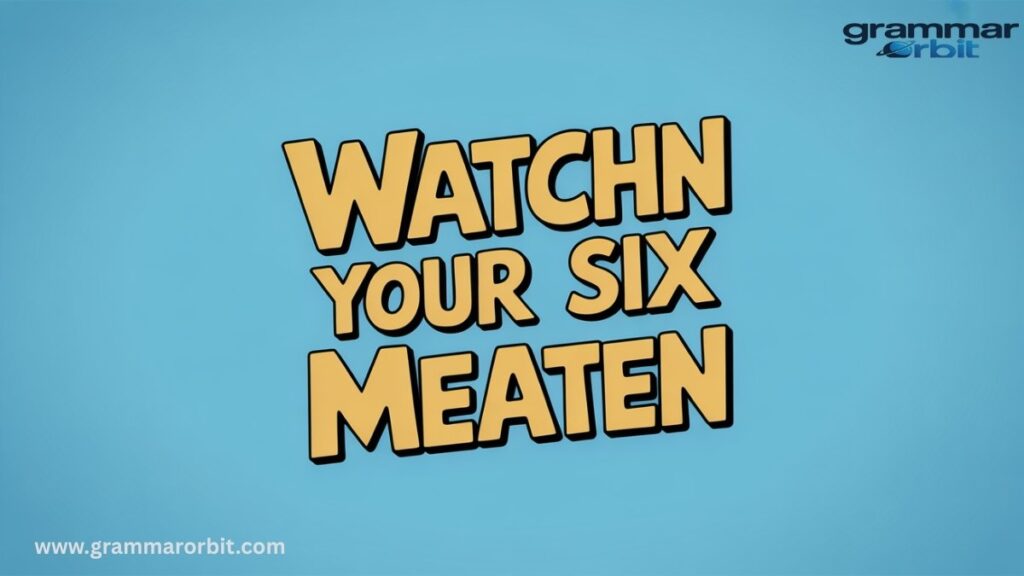Ever been so busy fighting workplace fires that you’ve completely neglected your own rear flank? You’re not alone. We’ve all been there, so focused on the chaos in front of us that we miss the metaphorical pie heading straight for the back of our heads. This is precisely why you need to understand the powerful, life saving phrase: watch your six. This isn’t just cool military slang; it’s your ultimate guide to avoiding professional ambushes. Consider this your official heads up to stop getting blindsided and start building a team that truly has your back. Let’s dive in
Cracking the Code: The Clock Face That Could Save Your Life
So, what does “watch your six” mean in plain English? The idiom meaning is brilliantly simple, but its genius is in its imagery.
Forget complex explanations. Just imagine you’re standing in the middle of a giant clock.
- 12 o’clock is straight ahead what you can see clearly.
- 3 o’clock is directly to your right.
- 9 o’clock is to your left.
Now, turn around. That spot directly behind you, your most vulnerable blind spot? That’s 6 o’clock.
When someone tells you to “watch your six,” they are sending a clear, urgent signal: “There is a threat approaching from behind. Stay alert.” It’s a call to heighten your awareness of your surroundings.
But the phrase has a more powerful counterpart: “I’ve got your six.” This isn’t a warning; it’s a pledge. It means, “Your back is covered. Focus on what’s in front of you, and trust me to guard you from the dangers you can’t see.” This simple statement is the foundation of trust in teams from the battlefield to the boardroom.
What Does “Smoke Show” Mean? The Surprising Truth Behind
From Dogfights to the Boardroom

The origin of “watch your six” is firmly rooted in the early days of aerial combat. During World War I, pilots in fragile biplanes needed a quick, unambiguous way to communicate enemy positions over crackling radios. Using the clock positions was the perfect solution.
“The phrase was less about being clever and more about survival,” notes a historian at the National WWII Museum. “In a dogfight, if you heard ‘Bandits at your six!’, you didn’t have time to think. You had to react. That phrase was a lifeline.”
This military term was so effective it became standard procedure, spreading from the Air Force to infantry, police units, and SWAT teams. Its journey into public consciousness was turbocharged by popular culture. Classic films like Top Gun and countless video games like Call of Duty made the terminology accessible and cool.
But its explosion into office jargon points to a deeper need. In today’s complex corporate environment, the threats aren’t bullets, but they can still be career-ending: a lurking competitor, a critical flaw in a presentation, or a colleague undermining your project. The principle is the same. You need people who will warn you and have your back.
Your Situational Awareness Toolkit

While the “six” gets all the attention, true situational awareness means understanding the entire clock. This is a standard framework in tactical communication that you can apply directly to your work and life.
| Clock Position | What It Means | Professional Context Example |
|---|---|---|
| 12 O’Clock | The direct, immediate threat or focus. | The client you’re presenting to. The project deadline. |
| 1-2 O’Clock | Threats developing on your far right. | A new market entrant. A department whose goals are misaligning. |
| 3 O’Clock | Your immediate right flank. | Your direct teammate. A parallel project you’re collaborating on. |
| 4-5 O’Clock | Your far right/rear blind spot. | Office gossip. A junior employee’s mistake about to become public. |
| 6 O’Clock | Your direct blind spot. | A peer competing for the same promotion. A critical data error you missed. |
| 7-8 O’Clock | Your far left/rear blind spot. | Industry regulations about to change. A supplier’s instability. |
| 9 O’Clock | Your immediate left flank. | Another direct teammate. A supportive but separate team. |
Understanding this full spectrum transforms you from someone who just hears a warning into someone who is fully aware of their entire environment. It’s the difference between staying vigilant and being caught off guard.
The Hidden World of the Soda Tab
Your Phrasebook for Trust: Choosing the Right Words for the Moment

“Watch your six” is powerful, but it’s not a universal tool. Using it in the wrong context can sound jarring or unprofessional. The key to great team communication is having a diverse toolkit.
For Direct, Actionable Warnings
Use these when you need to get someone’s attention now.
- Heads up! (The universal standard)
- Behind you! (For immediate physical or situational proximity)
- Look out for [Specific Thing]. (Adds crucial detail the original phrase lacks)
- Incoming! (Perfect for an approaching person or a fast unfolding problem)
- Check your rear. (A clean, direct translation)
For Professional and Office Settings
This is your guide for how to say watch your six professionally. These phrases maintain professionalism while conveying the warning.
- “You might want to circle back on the financials.” (Polite and specific)
- “Let’s make sure we’re aligned before we present.” (Focuses on teamwork)
- “We should have a contingency plan for that.” (Proactive and strategic)
- “There’s a potential hurdle with the legal department.” (Names the threat clearly)
- “Keep me posted on any developments.” (A softer way to stay in the loop and provide support)
For Pledging Support (“I’ve Got Your Six”)
These alternatives to watch your six build trust and show solidarity.
- “I’ll back you up.” (Simple, powerful, and clear)
- “You have my full support.” (Formal and unequivocal)
- “I’m here if you need me.” (Open-ended and pressure-free)
- “Let me run interference on that.” (Perfect for handling a difficult person for them)
- “We’re in this together.” (Builds powerful team solidarity)
Case Study: The Project Launch
Imagine a software team, “Alpha Team,” is days from a major launch. A developer, Maria, notices a critical bug that the team lead, Ben, has missed.
- The Wrong Way: Maria shouts across the office, “Hey Ben, watch your six!” This creates panic, sounds unprofessional, and doesn’t convey the specific problem.
- The Right Way: Maria pulls Ben aside and says, “Ben, I’ve got your back on the launch, but I just found a critical bug in the payment module. We need to circle back on it immediately.” This is professional, specific, and uses supportive language that reinforces teamwork.
The result? The problem gets solved without unnecessary drama, and trust within the team grows.
Tweek vs Tweak Clarifying the Difference and Usage
How to Gracefully Respond to Someone Having Your Six

Completing the circle of trust means knowing how to respond. Your reaction can either strengthen the bond or break it.
- The Acknowledging Nod: A simple “Copy that,” or “Thanks, I’m on it,” shows you’ve received the message and are taking charge. It’s confident and efficient.
- The Grateful Partner: “Thanks for having my back,” or “I appreciate you looking out,” explicitly acknowledges their effort and solidifies the relationship. This positive reinforcement makes them more likely to speak up again.
- The Collaborative Leader: “What are you seeing that I’m not?” or “Let’s tackle this together,” transforms the warning into a partnership. It shows you value their perspective and aren’t afraid to collaborate on a solution.
Reference: Cambridge Dictionary Definitions
Here’s a trusted source for clear word meanings:
Your “Watch Your Six” FAQs
What does “check your 6” or “checking your 6” mean?
This is just a slight variation of “watch your six.” Both mean the exact same thing: check what’s directly behind you. “Check your six” is often used for a quick, conscious glance, while “watch your six” implies a period of sustained awareness. In practice, they’re interchangeable.
What does “watching 6” mean?
This is a shortened, more casual form. If someone says they are “watching 6,” it means they are covering the rear, acting as a lookout, or providing backup. You’re most likely to hear this in gaming or tight knit team settings. It’s essentially saying, “I’ve got your six,” but from the perspective of the person doing the guarding.
What does “watch your 12” mean?
This one flips the script! If 6 o’clock is directly behind you, then 12 o’clock is straight ahead. Telling someone to “watch their 12” is a heads up about a direct, frontal threat. It’s like saying, “Heads up, the main issue is right in front of you!”
What does “watch your 20” mean?
“20” is not part of the standard clock system. This is a common mix up, often heard in movies or casual conversation. The person almost always means “watch your six.” The correct military term for location uses the 1-12 clock positions. So, if you hear “watch your 20,” you can safely assume they just got their slang mixed up and are warning you about a threat from behind.
What does “watch my 9” mean?
Now you’re thinking in 360 degrees! If you’re facing 12 o’clock, your 9 o’clock is directly to your left. So, if a teammate says, “Watch my 9,” they are asking you to cover their left flank. This shows a higher level of tactical awareness, with team members coordinating to cover each other’s specific blind spots across the entire clock face.
The Final Word
So, the next time you stride into the corporate jungle or a chaotic Monday meeting, remember your new favorite phrase. You’re now armed with more than just a cool piece of slang; you have a whole communication toolkit to watch your six, cover someone else’s, and generally avoid professional pies to the face. Go forth and be the guardian angel your colleagues don’t know they need. Just maybe don’t yell “INCOMING!” in the breakroom over the last donut. Some situations still call for a little stealth
JHON AJS is an experienced blogger and the creative voice behind the website grammarorbit.com, namely Grammar Orbit. With a keen eye for language and a passion for wordplay, he creates engaging grammar insights, word meanings, and clever content that make learning English enjoyable and interesting for readers.






